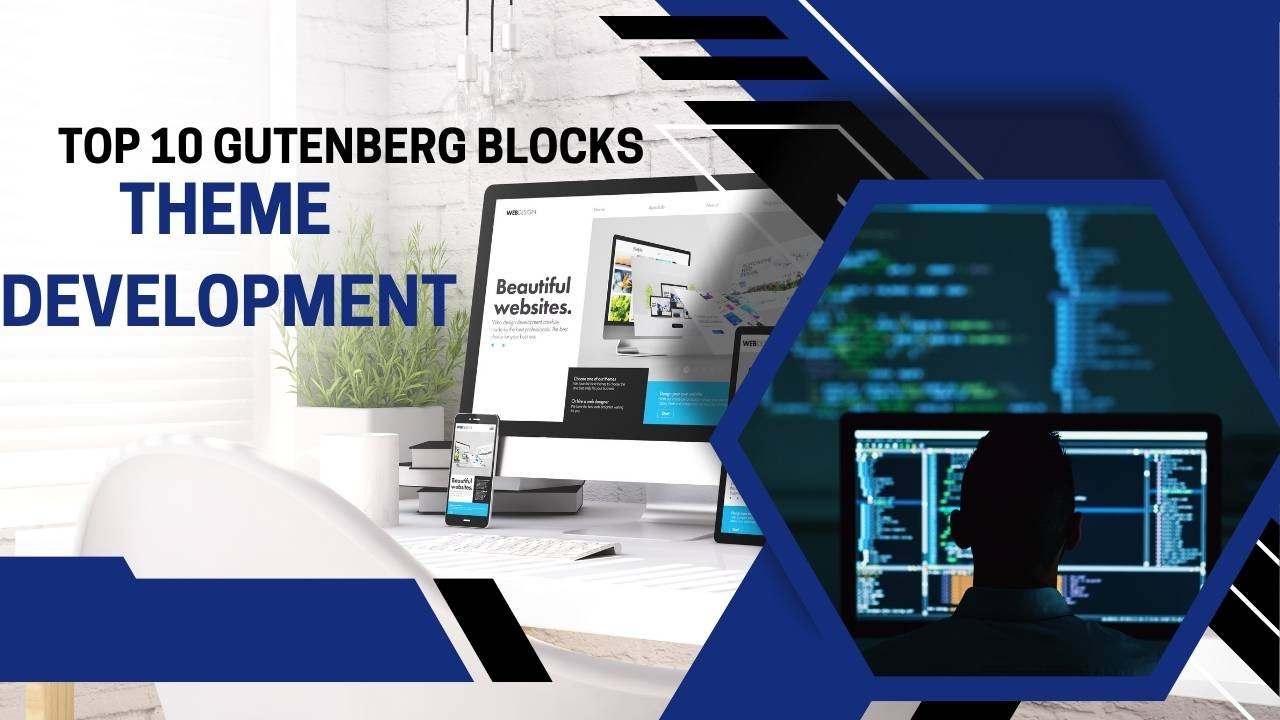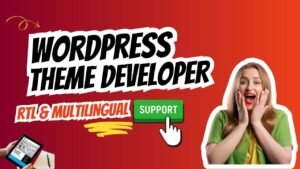Discover the top 10 Gutenberg blocks that every WordPress theme developer must master. Learn how core blocks like Columns, Query Loop, Cover, and Buttons enhance flexibility, improve editorial experience, and boost theme compatibility.
Introduction
As a theme developer working with WordPress’s block-based editor, mastering the right set of core blocks is essential. The Gutenberg editor (aka the Block Editor) uses modular blocks to build content, making theme design far more flexible. While there are dozens of blocks, focusing on key ones ensures you provide a smooth editing experience, robust layout control, and future-proof compatibility. Below are the Top 10 Gutenberg Blocks every theme developer should know — along with how to use them, why they matter for theme development, and helpful tips.
Top 10 Gutenberg Blocks for Theme Developers
Paragraph Block
The most basic and ubiquitous content block.
Why it matters
- Almost every post or page uses the Paragraph block. Ensuring your theme’s typography, spacing, and color styles are well-handled for paragraphs is foundational.
Tips
- Ensure your theme’s theme.json supports custom typography sizes, line-heights, and color palettes so editors get consistent styling.
Use case
- Blog posts, content sections, rule-text areas.
Heading Block
Used to add headings (H2, H3, etc.).
Why it matters
- Proper headings are critical for accessibility, SEO, and theme structure. The editor allows switching heading levels, so your theme must ensure a consistent appearance across levels.
Tips
- Define heading presets in theme.json and test various heading levels in the frontend to avoid style collisions
Use case
- Section titles, article headings, call-out headers.
Columns Block
Allows creation of responsive column layouts.
Why it matters
- Many themes support multi-column content; the Columns block is the way editors build such layouts in Gutenberg. Recognising nested blocks (child blocks) and ensuring your theme handles column widths, gaps, and responsiveness is vital.
Tips
- In theme.json, set proper spacing and breakpoints for .wp-block-columns and .wp-block-column. Consider wide-width/full-width support.
Use case
- Two-column text/image layouts, feature grids, side-by-side content.
Cover Block
Allows creation of responsive column layouts.
Why it matters
- Hero sections, landing pages, and modern blog intros often use cover blocks. Themes should support overlay color, contrast, wide/full alignment, and background handling.
Tips
- Add sensible default overlay colours, ensure legible text contrast on backgrounds, and support mobile behaviour (e.g., video fallback or static image).
Use case
- Hero banner, featured section, intro area.
Buttons Block (or Button Group)
Allows creation of responsive column layouts.
Why it matters
- Editors often need to insert actionable links (buttons). Ensuring your theme styles .wp-block-button and .wp-block-buttons elegantly and consistently help deliver professional UI.
Tips
- Provide default button styles in theme.json (colors, border-radius, hover states). Also support custom styles or variations (primary, secondary).
Use case
- Download link, signup button, internal link in pages.
Media & Text Block
Combines media (image/video) and text side-by-side.
Why it matters
- Many content layouts demand text alongside an image or video. The Media & Text block offers that with alignment control. The theme must ensure image size, text wrapping, and mobile behaviour are smooth.
Tips
- Handle nested structures – e.g., ensure inner image scales, text column keeps readability on narrow viewports.
Use case
- Feature section, service description with image, author spotlight.
Media & Text Block
One of the more advanced blocks: allows listing and templating posts.
Why it matters
- For themes built with block-based templates (Full Site Editing or FSE), this block is key to building blog archives, custom post type listings, and grid layouts without PHP templates.
Tips
- Provide block styles/patterns in your theme for Query Loop layouts, ensure your theme’s query templates (archive, category) are aligned with the FSE context. Understand how your theme supports dynamic data and block patterns.
Use case
- Blog grid, cards listing, latest posts section.
Template Part / Site Logo / Site Title Blocks
Blocks tied to Full Site Editing and theme-templating.
Why it matters
- With the rise of block themes, editors can visually edit headers, footers, and site elements. Blocks like Template Part, Site Log, and Site Title are central to the theme structure.
Tips
- If building a block theme, define your template parts in /block-patterns or /block-templates, include placeholders for these blocks, and provide customization options.
Use case
- Header with site logo + nav, footer template part, dynamic site title in page templates.
Group / Stack Blocks
Allows grouping multiple blocks for styling.
Why it matters
- Themes often need sections (like hero, features, testimonials) with custom backgrounds, padding, and responsive behaviour. Group (and Stack, if available) lets editors wrap blocks and apply styles uniformly.
Tips
- Define style options for .wp-block-group, include background colour support, width options (wide/full), and padding presets. Encourage pattern usage.
Use case
- Entire section with background image, testimonial grid, call-to-action strip.
Spacer / Separator Blocks
Simple but essential for layout control.
Why it matters
- While the above blocks cover major content needs, layout refinement often requires spacing or visual separators. Ensuring these blocks behave and the theme doesn’t override them inadvertently is important.
Tips
- Provide a sensible default height for the spacer, background colour for the separator, and consider mobile behaviour. Avoid theme-CSS that hides or breaks these blocks.
Use case
- Visual division between sections, extra white-space before footer, separator line in content.
Why Theme Developers Should Prioritise These Blocks
- Editorial experience:
By designing your theme with these blocks in mind, you provide a seamless editing experience — editors will “just find” the expected blocks and layouts.
- Layout flexibility:
These blocks cover most layout patterns (typography, hero, columns, listing, site structure) and let you avoid building countless custom blocks when the core does the job.
- Future-proofing
As WordPress evolves further into full-site editing and block-based themes, themes that support and leverage core blocks will age better.
- Performance & compatibility
Using core blocks means relying on well-tested code rather than custom shortcodes or legacy meta fields — which improves compatibility, reduces maintenance overhead, and may benefit performance.
- SEO & accessibility
Blocks like Heading, Paragraph, Query Loop have implications for structure, semantics, and content output — making them relevant both for editors and for theme SEO/markup.
Best Practices for Integrating These Blocks in Your Theme
- Use theme.json
Define custom colour palettes, typography, width settings, and block style presets to control how blocks render.
- Support wide and full alignment
Enable .alignwide and .alignfull handling if your theme layout allows.
- Provide block patterns
Pre-defined layouts using combinations of the above blocks help users get started quickly.
- Test responsiveness
For blocks like Columns, Media & Text, Spacer — ensure behavior on mobile is correct (stacking vs side-by-side).
- Ensure compatibility with FSE
If you support block themes, ensure blocks like Template Part, Query Loop are correctly stylised, and your block templates exist.
- Avoid excessive overrides
Don’t override core block behavior unnecessarily; let the user take advantage of block updates.
- Documentation for editors:
Since theme developers build for editors, include guidance on how to use blocks, especially advanced blocks like Query Loop.
- Accessibility & semantic markup
Ensure headings follow hierarchy, buttons use link semantics, alt text on images, and aria labels where needed.
- Performance matters
Some blocks (Gallery, Query Loop) can generate heavy output – optimise images, lazy-load, and ensure your theme doesn’t add excessive CSS/JS for block handling.
- Update path
Monitor WordPress and Gutenberg updates — new blocks, deprecations, and capabilities will evolve.
Conclusion
By focusing on these ten foundational Gutenberg blocks — Paragraph, Heading, Columns, Cover, Buttons, Media & Text, Query Loop, Template Part/SiteBlocks, Group/Stack, and Spacer/Separator — you, as a theme developer, equip yourself to handle most modern layout and editing scenarios.
When you combine good styling via theme.json, responsive handling, performance optimization, and strong editorial experience, your theme will stand out for robustness, flexibility, and future-readiness in the evolving WordPress ecosystem.
Top 10 FAQs
-
What is a Gutenberg block? A block is a modular unit of content in the WordPress Block Editor — for example, a paragraph, image, or button — that editors can insert and customise.
-
Why should theme developers care about Gutenberg blocks? Because themes must style and support those blocks properly to give editors a smooth experience, and because block-based layouts are increasingly standard in modern WordPress themes
-
Do I need to create custom blocks instead of using core blocks? Not always. If the core blocks cover your layout needs and your theme styles them well, custom blocks may not be necessary — focus on styling, pattern, and integration first.
-
What is the Query Loop block, and why is it important? The Query Loop block lets editors build listings (posts, custom post types) with templating in the editor. For theme developers, it’s key for archive/loop layouts and FSE support.
-
How does the Columns block work for responsive design? The Columns block nests column blocks inside; the theme must ensure columns wrap or stack appropriately on mobile and respect wide/full alignments and spacing.
-
What role does theme.json play in block support? theme.json lets you define global block styles, colour palettes, typography, spacing, and control support for blocks — making block styling consistent across your theme.
-
Is Full Site Editing (FSE) relevant to these blocks? Yes. Blocks like Template Part, Site Title, Query Loop, and patterns are FSE-relevant, and themes designed for FSE must ensure compatibility and styling for these.
-
How do I ensure accessibility with blocks? Make sure heading levels are correct, buttons are semantic links, alt text for images, sufficient colour contrast, and test keyboard navigation for block-based layouts.
-
What about performance issues with blocks like Gallery or Query Loop? Optimise image assets, use lazy-loading, avoid heavy custom JS for block output, and ensure your theme enqueues minimal additional scripts/styles.
-
How do I provide editorial guidance for users using blocks? Include documentation or help-tabs in your theme, provide block patterns for common layouts, and consider README or tutorial videos so editors use blocks correctly without breaking layout.
Media & Text Block

Monetising WordPress Themes & Plugins: Licence Models, Free-vs-Pro Strategy & Affiliate Marketing
Read More »
Theme Security Best Practices: Protecting Your Users and Building a Trusted Brand (2025 Edition)
Read More »





Leave a Reply